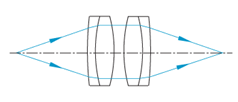Achromatic cemented lenses
Achromatic lenses consist of two or three lens elements and have significantly better performance than single lenses. The lenses in an achromatic doublet or triplet are cemented together, or have an air space between them, and usually have both positive and negative lenses, with different refractive indices. This multi-element design offers many advantages, including reduced chromatic aberration, improved monochromatic light imaging, and improved off-axis performance. The different types of achromatic lenses and their properties (such as conjugate ratio and damage threshold) are described further down this page. These achromatic lenses should be considered for any application with demanding imaging or laser beam manipulation needs.
Achromatic cemented lensesDescription
Reduce chromatic aberration
Because the refractive index of a material depends on the incident wavelength, the focal length of a single lens depends on the incident wavelength. This results in blurred focus when single lenses are used with white light sources. This phenomenon is called chromatic aberration. Achromatic lenses partially compensate for chromatic aberration by virtue of their multi-element design.

The constituent optical elements of an achromatic lens generally include a positive lens and a negative lens, which have different degrees of dispersion. Chromatic aberrations can be partially counteracted if the material dispersion values and focal lengths of these compositional builds are carefully chosen. Typically, achromatic lenses are designed to have the same focal length for two wavelengths on opposite sides of the visible spectrum. This produces a nearly constant focal length over a wide range of wavelengths.
The use of achromatic lenses is advantageous in any broadband imaging application utilizing a large wavelength range. Figure 1 shows the effect of focal length when many different wavelengths of light are incident on plano-convex singlets and achromatic doublets. Replacing the singlet with an achromatic doublet reduces the diameter of the focal point from 147 µm to 17 µm.
maging with improved monochromatic light

When the optical system uses monochromatic light, the chromatic aberrations discussed above are irrelevant. However, spherical singlets may still introduce significant monochromatic aberrations, such as spherical and coma. The multi-element design of the achromatic lens reduces these aberrations and results in significantly improved image quality and improved focusing of monochromatic light. For example, Figure 2 compares the ability of a plano-convex lens to focus monochromatic light with an achromatic doublet. As can be seen, the focal diameter of a doublet is 4.2 times smaller than that of a triplet.
Excellent off-axis performance
For spherical singlets, the effects of off-axis aberrations can severely affect the performance of the lens if the beam does not propagate through the exact center of the lens. Achromatic lenses are insensitive to centering, ie, the off-axis beam is focused at nearly the same point as the on-axis beam. In general, achromatic triplets are better at correcting for these off-axis effects than doublets.
 Figure 3 shows two Ø25 mm, f=50.0 mm lenses, one a plano-convex spherical singlet and the other an achromatic doublet. Each lens has a beam of light propagating along the optical axis, and another beam of light propagating parallel to the optical axis but 8 mm away from it. Achromatic doublets reduce both lateral and longitudinal aberrations; the lateral displacement of the focal point (circled in the figure) is reduced by a factor of 6, and the focal point diameter is significantly reduced.
Figure 3 shows two Ø25 mm, f=50.0 mm lenses, one a plano-convex spherical singlet and the other an achromatic doublet. Each lens has a beam of light propagating along the optical axis, and another beam of light propagating parallel to the optical axis but 8 mm away from it. Achromatic doublets reduce both lateral and longitudinal aberrations; the lateral displacement of the focal point (circled in the figure) is reduced by a factor of 6, and the focal point diameter is significantly reduced.
Choosing an Achromatic Lens
Achromatic lenses are a good choice for any demanding optical application because they offer substantially better performance than spherical singlets. Achromatic doublets are sufficient for most applications with infinite conjugation, and doublet pairs are ideal for finite conjugation. However, the adhesives used in these optical components reduce their damage threshold and limit their usability in high power systems. Air-spaced doublets are ideal for high power applications because they have a greater damage threshold than achromatic doublets. In addition, air-spaced doublets have two more design variables than doublets because the inner surfaces of the lenses do not need to have the same curvature. These additional variables allow air-spaced doublets to far outperform doublets in terms of transmitted wavefront error, spot size, and aberrations. However, air-spaced doublets are also more expensive than doublets.
Achromatic triplets are available in finite conjugate ratio (Steinheil triplet) and infinite conjugate ratio (Hastings triplet) designs. In the middle of these triplets is a low index optic cemented between two identical high index outer optics. They are capable of correcting both axial and lateral chromatic aberrations, and their symmetrical designs provide better performance than cemented doublets.
|
Achromatic cemented lenses |
|
|
Doublet cemented |
Air Spaced Doublet |
 |
 |
| Achromatic doublets have many advantages over simple singlets. They include minimal chromatic aberration, improved off-axis performance, and a smaller focal spot. These doublets have a positive focal length and are optimized for infinite conjugate ratios. | Air-spaced doublets perform better than doublets because their lenses are separated. These optics are ideal for high power applications because they have a larger damage threshold than doublets. These doublets have a positive focal length and are optimized for infinite conjugate ratios. |
|
doublet lens pair |
Achromatic triplet cemented |
 |
 |
| Achromatic doublet pairs have the advantages of achromatic lenses while being optimized for finite conjugation. These lens pairs are ideal for image relay and magnification systems. | Achromatic triplets perform better than achromatic doublets. An achromatic triplet is the simplest lens that can correct all major chromatic aberrations. Steinheil triplets are optimized for finite conjugate ratios, while Hastings triplets are optimized for infinite conjugate ratios. |



